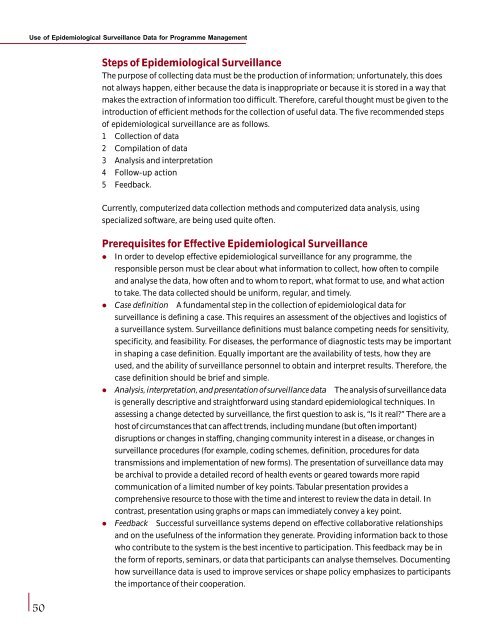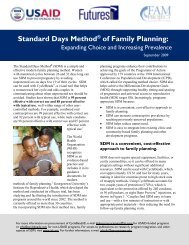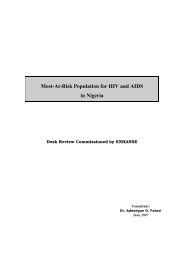Health Policy Issues and Health Programmes in ... - Amazon S3
Health Policy Issues and Health Programmes in ... - Amazon S3
Health Policy Issues and Health Programmes in ... - Amazon S3
- No tags were found...
You also want an ePaper? Increase the reach of your titles
YUMPU automatically turns print PDFs into web optimized ePapers that Google loves.
Use of Epidemiological Surveillance Data for Programme ManagementSteps of Epidemiological SurveillanceThe purpose of collect<strong>in</strong>g data must be the production of <strong>in</strong>formation; unfortunately, this doesnot always happen, either because the data is <strong>in</strong>appropriate or because it is stored <strong>in</strong> a way thatmakes the extraction of <strong>in</strong>formation too difficult. Therefore, careful thought must be given to the<strong>in</strong>troduction of efficient methods for the collection of useful data. The five recommended stepsof epidemiological surveillance are as follows.1 Collection of data2 Compilation of data3 Analysis <strong>and</strong> <strong>in</strong>terpretation4 Follow-up action5 Feedback.Currently, computerized data collection methods <strong>and</strong> computerized data analysis, us<strong>in</strong>gspecialized software, are be<strong>in</strong>g used quite often.50Prerequisites for Effective Epidemiological Surveillancel In order to develop effective epidemiological surveillance for any programme, theresponsible person must be clear about what <strong>in</strong>formation to collect, how often to compile<strong>and</strong> analyse the data, how often <strong>and</strong> to whom to report, what format to use, <strong>and</strong> what actionto take. The data collected should be uniform, regular, <strong>and</strong> timely.l Case def<strong>in</strong>ition A fundamental step <strong>in</strong> the collection of epidemiological data forsurveillance is def<strong>in</strong><strong>in</strong>g a case. This requires an assessment of the objectives <strong>and</strong> logistics ofa surveillance system. Surveillance def<strong>in</strong>itions must balance compet<strong>in</strong>g needs for sensitivity,specificity, <strong>and</strong> feasibility. For diseases, the performance of diagnostic tests may be important<strong>in</strong> shap<strong>in</strong>g a case def<strong>in</strong>ition. Equally important are the availability of tests, how they areused, <strong>and</strong> the ability of surveillance personnel to obta<strong>in</strong> <strong>and</strong> <strong>in</strong>terpret results. Therefore, thecase def<strong>in</strong>ition should be brief <strong>and</strong> simple.l Analysis, <strong>in</strong>terpretation, <strong>and</strong> presentation of surveillance data The analysis of surveillance datais generally descriptive <strong>and</strong> straightforward us<strong>in</strong>g st<strong>and</strong>ard epidemiological techniques. Inassess<strong>in</strong>g a change detected by surveillance, the first question to ask is, “Is it real?” There are ahost of circumstances that can affect trends, <strong>in</strong>clud<strong>in</strong>g mundane (but often important)disruptions or changes <strong>in</strong> staff<strong>in</strong>g, chang<strong>in</strong>g community <strong>in</strong>terest <strong>in</strong> a disease, or changes <strong>in</strong>surveillance procedures (for example, cod<strong>in</strong>g schemes, def<strong>in</strong>ition, procedures for datatransmissions <strong>and</strong> implementation of new forms). The presentation of surveillance data maybe archival to provide a detailed record of health events or geared towards more rapidcommunication of a limited number of key po<strong>in</strong>ts. Tabular presentation provides acomprehensive resource to those with the time <strong>and</strong> <strong>in</strong>terest to review the data <strong>in</strong> detail. Incontrast, presentation us<strong>in</strong>g graphs or maps can immediately convey a key po<strong>in</strong>t.l Feedback Successful surveillance systems depend on effective collaborative relationships<strong>and</strong> on the usefulness of the <strong>in</strong>formation they generate. Provid<strong>in</strong>g <strong>in</strong>formation back to thosewho contribute to the system is the best <strong>in</strong>centive to participation. This feedback may be <strong>in</strong>the form of reports, sem<strong>in</strong>ars, or data that participants can analyse themselves. Document<strong>in</strong>ghow surveillance data is used to improve services or shape policy emphasizes to participantsthe importance of their cooperation.







